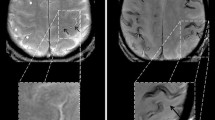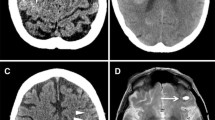Abstract
Supratentorial superficial siderosis (SS) is a frequent imaging marker of cerebral amyloid angiopathy (CAA). It is most probably caused by focal subarachnoid hemorrhages (fSAHs). Based on single-case observations, it has been proposed that such fSAHs might be a predisposing factor for future intracranial hemorrhage. Here we tested the hypothesis if a SS as a residue of fSAHs must be regarded as a warning sign for future intracranial hemorrhage. Fifty-one consecutive patients with SS and no apparent cause other than possible or probable CAA were identified through a database search and followed-up for a median interval of 35.3 months (range 6–120 months). Main outcome measures were rate and location of new intracranial hemorrhages. Twenty-four patients (47.1 %) had experienced any new intracranial hemorrhage, 18 patients (35.3 %) had an intracerebral hemorrhage (ICH), and in 13 of them (25.5 %), the hemorrhage was located at the site of pre-existing siderosis. Six patients (11.7 %) had developed a new subarachnoid hemorrhage (SAH), four of them at the site of siderosis. Patients with SS are at substantial risk for subsequent intracranial hemorrhage. SS can be considered a warning sign of future ICH or SAH, which frequently occur adjacent to pre-existing SS. Prospective studies are needed to confirm these findings.


Similar content being viewed by others
References
Linn J, Halpin A, Demaerel P, Ruhland J, Giese AD, Dichgans M, van Buchem MA, Bruckmann H, Greenberg SM (2010) Prevalence of superficial siderosis in patients with cerebral amyloid angiopathy. Neurology 74:1346–1350
Linn J, Herms J, Dichgans M, Brückmann H, Fesl G, Freilinger T, Wiesmann M (2008) Subarachnoid hemosiderosis and superficial cortical hemosiderosis in cerebral amyloid angiopathy. AJNR Am J Neuroradiol 29:184–186
Kumar S, Goddeau RP Jr, Selim MH, Thomas A, Schlaug G, Alhazzani A, Searls DE, Caplan LR (2010) Atraumatic convexal subarachnoid hemorrhage: clinical presentation, imaging patterns and etiologies. Neurology 74:893–899
Finelli PF (2010) Cerebral amyloid angiopathy as cause of convexity SAH in elderly. Neurologist 16:37–40
Renard D, Castelnovo G, Wacongne A, Le Floch A, Thouvenot E, Mas J, Gabelle A, Labauge P, Lehmann S (2012) Interest of CSF biomarker analysis in possible cerebral amyloid angiopathy cases defined by the modified Boston criteria. J Neurol. doi:10.1007/s0041501265208
Charidimou A, Gang Q, Werring DJ (2012) Sporadic cerebral amyloid angiopathy revisited: recent insights into pathophysiology and clinical spectrum. J Neurol Neurosurg Psychiatry 83:124–137
Yamada M (2012) Predicting cerebral amyloid angiopathy-related intracerebral hemorrhages and other cerebrovascular disorders in Alzheimer’s disease. Front Neurol 3:1–8
Katoh M, Yoshino M, Asaoka K, Aoki T, Imamura H, Kashiwazaki D, Takano K, Aida T (2007) A restricted subarachnoid hemorrhage in the cortical sulcus in cerebral amyloid angiopathy: could it be a warning sign? Surg Neurol 68:457–460
Kawahara I, Nakamoto M, Matsuo Y, Tokunaga Y (2010) A case of cerebral amyloid angiopathy in which a restricted subarachnoid hemorrhage recurred in the cortical sulcus following a subcortical hemorrhage. No Shinkei Geka 38:551–555
Knudsen KA, Rosand J, Karluk D, Greenberg SM (2001) Clinical diagnosis of cerebral amyloid angiopathy: validation of the Boston criteria. Neurology 56:537–539
Greenberg SM, Eng JA, Ning M, Smith EE, Rosand J (2004) Hemorrhage burden predicts recurrent intracerebral hemorrhage after lobar hemorrhage. Stroke 35:1415–1420
Samarasekera N, Smith C, Al-Shahi Salman R (2012) The association between cerebral amyloid angiopathy and intracerebral haemorrhage: systematic review and meta-analysis. J Neurol Neurosurg Psychiatry 83:275–281
Biffi A, Sonni A, Anderson CD et al (2010) Variants at APOE influence risk of deep and lobar intracerebral hemorrhage. Ann Neurol 68:934–943
Biffi A, Anderson CD, Jagiella JM et al (2011) APOE genotype and extent of bleeding and outcome in lobar intracerebral hemorrhage: a genetic association study. Lancet Neurol 10:702–709
Dierksen GA, Skehan ME, Khan MA, Jeng J, Nandigam RN, Becker JA, Kumar A, Neal KL, Betensky RA, Frosch MP, Rosand J, Johnson KA, Viswanathan A, Salat DH, Greenberg SM (2010) Spatial relation between microbleeds and amyloid deposits in amyloid angiopathy. Ann Neurol 68:545–548
Takeda S, Hinokuma K, Yamazaki K, Onda K, Miyakawa T, Ikuta F, Arai H (2012) The hemorrhage caused by sporadic-type cerebral amyloid angiopathy occurs primarily in the cerebral sulci. Neuropathology 32:38–43
Takeda S, Yamazaki K, Miyakawa T, Onda K, Hinokuma K, Ikuta F, Arai H (2003) Subcortical hematoma caused by cerebral amyloid angiopathy: does the first evidence of hemorrhage occur in the subarachnoid space? Neuropathology 23:254–261
Roch JA, Nighoghossian N, Hermier M, Cakmak S, Picot M, Honnorat J, Derex L, Trouillas P (2005) Transient neurologic symptoms related to cerebral amyloid angiopathy: usefulness of T2*-weighted imaging. Cerebrovasc Dis 20:412–414
Izenberg A, Aviv RI, Demaerschalk BM, Dodick DW, Hopyan J, Black SE, Gladstone DJ (2009) Crescendo transient Aura attacks: a transient ischemic attack mimic caused by focal subarachnoid hemorrhage. Stroke 40:3725–3729
Brunot S, Osseby GV, Rouaud O, Kazemi A, Ricolfi F, Couvreur G, Catteau A, Hervieu M, Moreau T, Giroud M, Béjot Y (2010) Transient ischemic attack mimics revealing focal subarachnoid hemorrhage. Cerebrovasc Dis 30:597–601
Beitzke M, Gattringer T, Enzinger C, Wagner G, Niederkorn K, Fazekas F (2011) Clinical presentation, etiology, and long-term prognosis in patients with nontraumatic convexal subarachnoid hemorrhage. Stroke 42:3055–3060
Acknowledgments
We would like to thank all the patients and their guardians for participating in this study.
Conflicts of interest
The authors declare that they have no conflict of interest related to this study. Dr. Dichgans is a consultant for the following companies: Bayer Vital GmbH, Boehringer Ingelheim Pharma GmbH & Co. KG, Biologische Heilmittel Heel GmbH, Bristol-Myers Squibb GmbH & Co. KgaA, and Trommsdorff GmbH & Co. KG. Honoraria he gets from Bayer Vital GmbH, Boehringer Ingelheim Pharma GmbH & Co. KG, Biologische Heilmittel Heel GmbH, Bristol-Myers Squibb GmbH & Co. KgaA, Lundbeck GmbH, Sanofi-Aventis Deutschland GmbH, Shire Deutschland GmbH, Deutsches Zentrum für Neurodegenerative Erkrankungen e. V. (DZNE), Georg Thieme Verlag KG, UpToDate, and W. Kohlhammer GmbH. He acts as principal investigator or gets research funding from Bayer Vital GmbH, Eisai Medical Research Inc., Eisai Ltd., Essex Pharma GmbH, Ferrer Internacional, S.A., and ICOn Clinical Research GmbH. Dr. Opherk has served on scientific advisors boards for Boehringer-Ingelheim Pharma GmbH & Co. KG and Bristol-Myers Squibb GmbH & Co. KgaA and has received speaker honoraria from Boehringer-Ingelheim Pharma GmbH & Co. KG. All other authors declare that they have no conflict of interest unrelated to this study.
Ethical standard
The study has been approved by the appropiate ethics committee and has therefore been performed in accordance with the ethical standards laid down in the 1964 Declaration of Helsinki.
Author information
Authors and Affiliations
Corresponding author
Rights and permissions
About this article
Cite this article
Linn, J., Wollenweber, F.A., Lummel, N. et al. Superficial siderosis is a warning sign for future intracranial hemorrhage. J Neurol 260, 176–181 (2013). https://doi.org/10.1007/s00415-012-6610-7
Received:
Revised:
Accepted:
Published:
Issue Date:
DOI: https://doi.org/10.1007/s00415-012-6610-7




